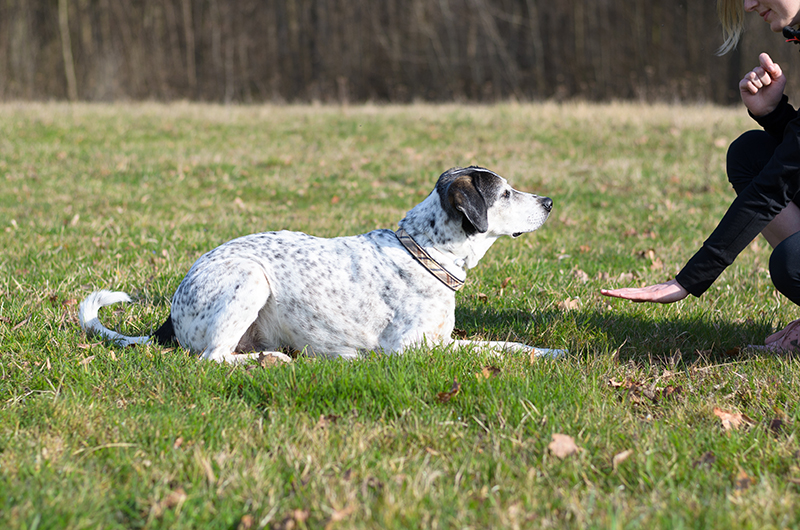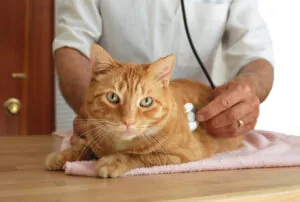Training Tips: TEACHING PLACE

Here are some basic rules that work well for any kind of command you’re trying to teach your dog, including the place command. Here are some general guidelines:
Pick a Quiet Environment
As any professional dog trainer will tell you, you always want to start by working in an environment with minimal distraction. It’s also helpful if it’s a familiar and comfortable location like your home. Once your dog masters the command in that kind of environment, you can then move on to areas of more distractions. Just be sure to move at your dog’s pace and don’t try to rush it. Another great tip is to keep your initial training sessions short, about 10 minutes or so, and then you can build up to 20-minute sessions, particularly as you start adding in distractions.
Begin with the Release Cue
The first thing you want to teach your dog is the release word you will use that lets him know when he can stop holding still. This release cue is vital for dog training because it tells your dog that he has to hold the position until you say something specific. The release cue should be something that you don’t use frequently. For example, you probably say the word ‘OK’ a lot in normal conversation, so you don’t want to use that as your release word. It will be confusing for your dog who will be hanging on your every word after you give him the place command. You might choose another word like ‘free’ or ‘break’ or ‘dog out’ or even ‘up’ to be your release word. These are words you’re not likely to use as much as ‘OK.’ To teach your dog about the release word, you’ll want to put him on the leash and lead him to the dog bed or mat that you’ll use for training. Get him up on top of the bed or mat, wait for just a second or two, and then use leash pressure to lure him back to where you are while you say the release word. As soon as he moves toward you, give him a treat as a form of positive reinforcement. Do that a few times but don’t exceed the short, 10-minute training session. Then be sure to give your dog a break and maybe even play with him before trying again. Many dog owners make the mistake of training their dog for too long. They need more breaks and lots of positive reinforcement to firmly cement that knowledge in their mind and make it a fun experience too.
Introduce the Place Command
Once your dog becomes proficient at the release cue, you can now teach them about ‘place’ and what it means. You can do this with clicker training or by simply reinforcing their good behavior with a ‘yes!’ Begin with a place cue to indicate the place command. It might be something like, ‘go to place,’ or simply ‘place.’ To introduce the place command, say the place cue and lead the dog to the dog bed or mat you’re using as their place. Once you have all four paws on the ‘place,’ reward your dog with lots of positive reinforcement like a dog treat, petting, the clicker, or loving words. As soon as you’ve rewarded your dog for going to their place, you can then use the release word to release them. Repeat this several times, but again, don’t go over the 10-minute training session time limit.
Add the Lie Down Command
After your dog has the idea of ‘go to place’ down, introduce the ‘lie down’ command. Your dog might already know this command, and that can work in your favor. If not, you can begin with a command like, ‘dog sit,’ and then, use some mild leash pressure to get him to lay down while saying, ‘lie down.’ Then, reward him with positive reinforcement. Practice the ‘lie down’ command several times until you see that your dog will do this without being asked. The goal is to get him to go to his ‘place’ and then ‘lie down’.
Increase the Duration
Once your dog learns the place command and the ‘lie down’ command in your quiet home environment, now it’s time to increase the duration. When you first begin, you’ll have your dog stay in place for just a few seconds before giving him the release word and rewarding him for his good behavior. After he’s got the basics down, you can now begin slowly increasing the time. You can use a command like ‘lie down/stay” or “dog stays.” Increase the time from a few seconds to a minute or two, then five minutes, and then ten minutes. As your dog is learning, be sure to give him plenty of breaks and loads of positive reinforcement.
Introduce Distractions
Once your dog learns to go to his place, lie down, and stay in place for a longer duration of time, you can now start to introduce distractions. These can be things like shaking the leash, making odd sounds, running around, or even hiding. You can also ask a friend to come by and knock on the door or bring them into the house and have them start talking to you. After you’ve mastered the 15 days of increasing duration and distractions, you’re now ready for the next step; changing locations.
New Locations
Before you change locations, you’ll want to make sure your dog has a good understanding of the place command and that he is able to relax even with distractions present. If he’s at that point in his dog training program, you can start taking him to new locations. If your dog is reactive, you’ll need to keep that in mind so that you don’t overwhelm him with places and situations where he will get too much stimulus during his training sessions. But if you think you’re ready, you might consider one of several places to take him to practice the place command. Local parks (not dog parks), hiking trails, bike paths, skate parks, near a playground or a school, or along common walking routes you and your dog enjoy are all good places to start.
Remember that you want to always use positive reinforcement, keep the training sessions short, and keep your own voice and behavior calm.
Share This Post
Recent Posts
About Shallowford Animal Hospital
Shallowford Animal Hospital and The Pet Spa at Shallowford are dedicated to the exceptional, compassionate care your pet deserves. Pets hold a very special place in our families, and we treat yours like our own.



